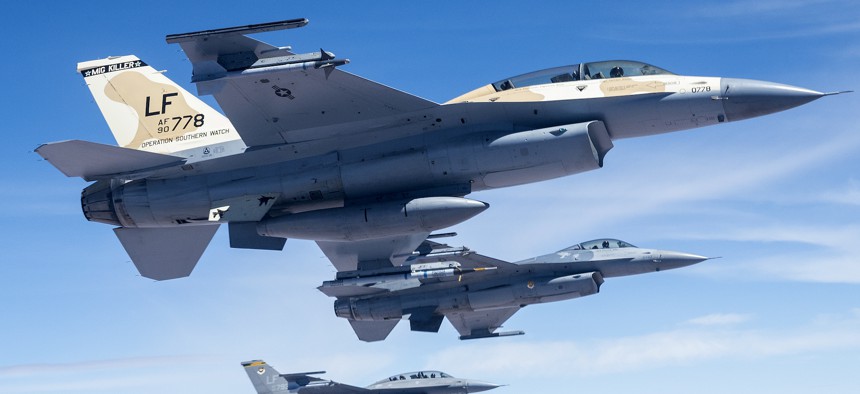
U.S. Air Force F-16 Fighting Falcons with Luke Air Force base prepare to be refueled by a KC-135 Stratotanker from the 161st Air Refueling Wing during a local sortie on Aug. 6, 2022. U.S. Air National Guard / Staff Sgt. James A. Richardson Jr.
The Air & Space Brief: Who’s the boss in a space war? Ukraine NASAM ammo; New aviation safety office; and more
Welcome to the Defense One Air and Space newsletter. Here are our top stories this week:
Space Command and Control: There’s still a division between intelligence and military operations in space, and two years into the U.S. Space Command and U.S. Space Force’s existence, there’s not a clear answer as to what would happen in a conflict that included space, and whether the combatant commander for space would lead the decision-making process.
“That's something we're working through,” National Reconnaissance Office director Christopher Scolese said Thursday during a Mitchell Institute discussion.
NASAM ammo for Ukraine: The United States announced $1 billion in additional security aid for Ukraine on Monday that includes ammunition for much-anticipated air defense systems that Kyiv has said are critical to defending against long-range Russian missile attacks. For the first time, the security package includes medium-range air-to-air missiles (AMRAAM) for the National Advanced Surface-to-Air Missile defense capabilities Ukraine will get from Norway.
New aviation safety office: When a military aircraft crashes, how the data is reported can vary widely from service to service, which makes it harder to spot trends. A new Pentagon office is trying to standardize this reporting—and keep military aircraft crashes from increasing again. The Joint Safety Council, was established June 28 by Deputy Defense Secretary Kathleen Hicks, and fulfills a primary recommendation of an independent commission into aviation accidents.
Spirit Aerosystems hypersonics: After taking a hard business hit during the pandemic because of its heavy commercial aviation portfolio, Spirit Aerospace has diversified. Over the last 16 months, executives have come up with a plan that includes becoming a key supplier of hypersonic weapons and space systems to the large defense companies.
Sign up to get The Air & Space Brief every Tuesday from Tara Copp, Defense One’s Senior Pentagon Reporter. On Aug. 9, 2010, A JetBlue flight attendant grabbed two beers, hit the emergency slide, and departed his aircraft after poor treatment from a passenger.
 From Defense One
From Defense One
If War Comes to Space, Who Will Control US Spy Satellites? // Tara Copp
U.S. intelligence and military are speeding new sensors to space. They are still working on details of who's ultimately in charge during a conflict.
White House Sending Key Air Defense System Ammunition To Ukraine // Tara Copp
Between 70,000 and 80,000 Russian troops have been hurt or killed in Ukraine, in 'most intense' conventional combat since WWII, DOD says.
Can a New Aviation Safety Office Avoid Its Predecessors' Mistakes? // Tara Copp
And can it help salve annual mishap spikes caused by Congressional inaction?
Major Aerospace Supplier Spirit AeroSystems Looks to Expand Military, Space Business // Marcus Weisgerber
Company executives see the company playing a larger role in designing hypersonic weapons and next-generation aircraft.




